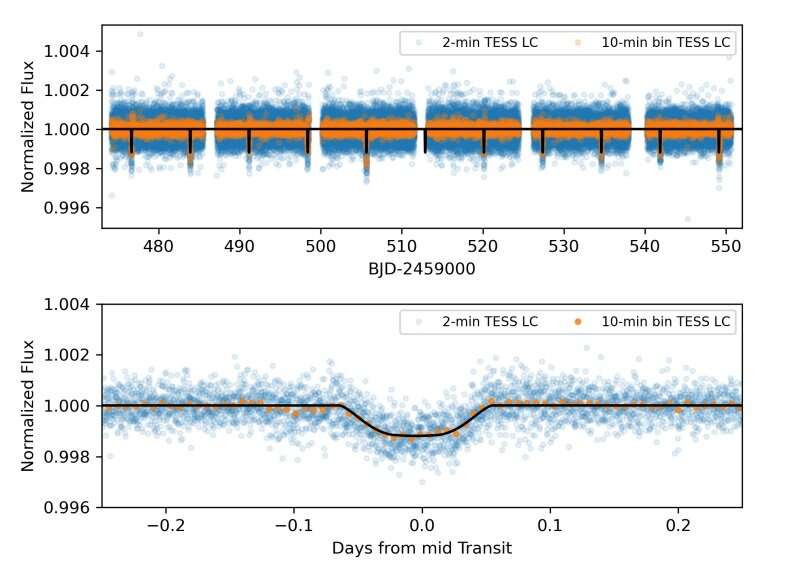The normalized PDCSAP (Pre-search Data Conditioning Simple Aperture Photometry) light curve for TOI-4603 is plotted with respect to time in the upper panel, and time in days from mid-transit is plotted in the lower panel. Credit: Khandelwal et al, 2023
Using NASA's Transiting Exoplanet Survey Satellite (TESS), astronomers have detected a new exoplanet orbiting a distant star. The newfound alien world, designated TOI-4603 b is the size of Jupiter and about 13 times more massive than the solar system's biggest planet. The finding was detailed in a paper published March 21 on the arXiv pre-print repository.
TESS spacecraft is conducting a survey of about 200,000 of the brightest stars near the sun with the aim of searching for transiting exoplanets. So far, it has identified more than 6,200 candidate exoplanets (TESS Objects of Interest, or TOI), of which 3,031 have been confirmed so far.
The group of astronomers led by Akanksha Khandelwal of the Physical Research Laboratory (PRL) in India, report that a transit signal has been identified in the light curve of a sub-giant F-type star known as TOI-4603, or HD 245134. The planetary nature of this signal was confirmed by follow-up radial velocity measurements taken with the PARAS (PRL Advanced Radial-velocity Abu-sky Search) and TRES (Tillinghast Reflector Echelle Spectrograph) spectrographs.
"TESS observed the star TOI-4603 (HD 245134) in three sectors 43, 44, and 45. All the observations were made with the two-minute cadence mode nearly continuously between September 16, 2021, and December 2, 2021 (∼ 74 days time-span) with a gap of ∼ 5.5 days due to the data transferring from the spacecraft," the researchers wrote in the paper.
TOI-4603 b has a radius of approximately 1.04 Jupiter radii and its mass is estimated to be about 12.89 Jupiter masses, which yields a density at a level of 14.1 g/cm3. The planet orbits its host every 7.24 days, at a distance of some 0.09 AU from it. The equilibrium temperature of TOI-4603 b was calculated to be 1,677 K.
The researchers underlined that the parameters of TOI-4603 b make it one of the most massive and densest giant exoplanets known to date. They added that the newly found extrasolar world is an important addition to the population of giant objects in the high-mass planet and low-mass brown dwarf overlapping region.
The study also found that the orbit of TOI-4603 b is eccentric—with an eccentricity at a level of 0.325. According to the astronomers, this finding, together with a relatively small orbital separation, suggests that the planet is likely undergoing the so-called high eccentricity tidal (HET) migration—a gravitational scattering due to another planet or star.
When it comes to the host star TOI-4603, the authors of the paper noted that it is a relatively bright star and a rapid rotator. The star is about 2.72 times larger than the sun, while its mass is approximately 1.75 solar masses. The age of TOI-4603 is estimated to be nearly two billion years and its effective temperature is at a level of 6,189 K.
More information: Akanksha Khandelwal et al, Discovery of a massive giant planet with extreme density around a sub-giant star TOI-4603, arXiv (2023). DOI: 10.48550/arxiv.2303.11841
Journal information: arXiv
© 2023 Science X Network
























